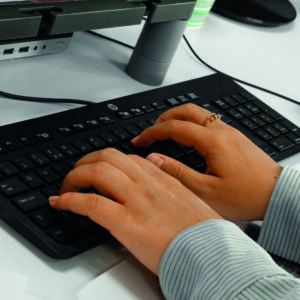A blog by Rosie Savage (Copywriter & Proofreader at Trident Marketing)
It’s fair to say that proofreading sounds easy: you read it, you spot a mistake, you correct it. Throughout my years as a professional proofreader, however, I’ve learned some invaluable lessons on how to do it well. Read on to discover my top tips, from reading it backwards (yes, really!) to using a crucial keyboard shortcut.
1. Print It Out
There are pros and cons to proofreading digitally or with a hard copy, but sometimes you just can’t beat putting (red) pen to paper. It gives you a much-needed break from your computer or phone screen, and you can sit somewhere different to change your surroundings too. Better still, when implementing any changes, you can whack out your highlighter pen and tick them off as you go. If digital is your only option, I recommend tracking changes so that checks on second proofs are more efficient.
2. Read It Backwards
The brain is a clever, clever thing – sometimes it automatically corrects written mistakes as you read them. Even more so if you wrote the piece yourself. Proofreading it backwards essentially turns it into gobbledegook, making you focus on each individual word. This may not always be practical because it’s time-consuming, but it’s a neat trick for important copy, such as headlines.

3. Change The Font
We’ve all got a go-to font, so changing it up for something different will offer a fresh perspective and wake up your brain. You could also change the font size for a similar effect. Proofreading work that’s been designed already? You could always copy and paste the text into a word document.
4. Take Your Time
If you’re able to, slow the pace down. You’re bound to miss errors when skim-reading at speed. Instead, read at a steady pace and go back over key areas a couple of times.
5. Take Regular Breaks!
Reading but not taking it in? Getting blurry vision? Your eyes could do with a break. Go make yourself a cuppa or walk around for a bit. If time is of the essence, follow the 20-20-20 rule: take a break of at least 20 seconds, every 20 minutes, looking at least 20 feet away.
6. Read It Out Loud
Your colleagues or family will love you for this one, but reading out loud is a gamechanger. Not only will you spot errors, but you’ll also be checking for flow and sentence structure. If you can’t say a sentence without catching your breath, it’s too long!
7. Use Ctrl F
I lose count of the number of times I press ‘Ctrl’ followed by ‘F’ on my keyboard. That’s the Find command. I primarily use it to target unintentional repetition, so I can replace some of the words with alternative options. It’s how I know I’ve used the word ‘copy’ six times in this blog!
8. Get It Double-Checked
I’m a proofreader by profession, but even I can miss the odd mistake. The number one rule of proofreading is to get copy checked by more than one person, so it’s not just edited by the individual who wrote it. At Trident Marketing, I’m not solely responsible for typos and grammatical errors – our whole team takes pride in proofing. Make sure you find out more about our copywriting and proofreading services.
9. Sleep On It
This one’s not always possible, but sleep on it if you can. Coming back to words with a fresh pair of eyes after a good night’s rest is ideal. At the very least, check it after a lunchbreak or different task.
10. Don’t Make Assumptions
Whatever you do, don’t assume that what you’re proofing is factually accurate. One of the most time-consuming aspects of proofreading is checking people’s names, place names, page numbers, dates, phone numbers, websites… the list could go on. Google is your best friend here.
11. Go Somewhere Quiet
Easily distracted? Go to a quiet room or buy noise-cancelling headphones so you can really focus. On the flip side of that, you might be someone who hates silence so having the radio on is preferable.
12. Post-It Note Your Pitfalls
We all have words that trip us up. ‘Occasionally’ always used to get me. And I very rarely read ‘beautiful’ without having Jim Carrey’s b-e-a-utiful in my ear – thanks Bruce Almighty. If there are words that you regularly get stuck on, why not put a Post-it note on or near your computer screen to remind you of the correct spelling?
13. Use Proofreading Tools Like Grammarly
Still need help? There are lots of plug-ins and apps that can help with proofreading. Grammarly is a great one that goes above and beyond spelling and grammar. Its AI-powered suggestions appear wherever you write, coaching over 30 million people and 50,000 teams every day to improve the correctness, clarity, engagement, and delivery of their writing. You can also use its Free Grammar Checker.
Combine these top tips and you’ll be onto a winner. Most importantly, find out what works for you.

